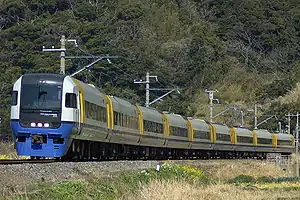255 series
The 255 series (255系), branded Bōsō View Express (房総ビューエクスプレス), is a DC electric multiple unit (EMU) train type operated by East Japan Railway Company (JR East) in Japan. It was introduced into commercial service on 2 July 1993,[1] and was specifically designed to serve on Limited express services from Tokyo to the Bōsō Peninsula.
| 255 series | |
|---|---|
 A 255 series EMU on a Wakashio service in August 2019 | |
| Manufacturer | Kinki Sharyo, Tokyu Car |
| Family name | Bōsō View Express |
| Replaced | 183 series |
| Constructed | 1993–1994 |
| Entered service | 2 July 1993 |
| Number built | 45 vehicles (5 trainsets) |
| Number in service | 45 vehicles (5 trainsets) |
| Formation | 9 cars per trainset |
| Fleet numbers | Be01 - Be05 |
| Operator(s) | JR East |
| Depot(s) | Makuhari |
| Line(s) served | Sōbu Main Line, Sotobō Line, Uchibō Line |
| Specifications | |
| Car body construction | Steel |
| Car length | 21,000 mm (68 ft 11 in) (end cars) 20,500 mm (67 ft 3 in) (intermediate cars) |
| Width | 2,946 mm (9 ft 8.0 in) |
| Height | 3,785 mm (12 ft 5.0 in) |
| Doors | 1 sliding door per side |
| Maximum speed | 130 km/h (80 mph) |
| Traction system | Variable frequency (IGBT) |
| Power output | 95 kW x 16 = 1,520 kW |
| Electric system(s) | 1,500 V DC overhead |
| Bogies | DT56E (motored), TR241E (trailer) |
| Safety system(s) | ATS-P, ATS-SN |
| Track gauge | 1,067 mm (3 ft 6 in) |
Design
The trains were built jointly by Kinki Sharyo and Tokyu Car,[2] with a steel body design based directly on the earlier 253 series EMUs built for Narita Express services, although the window height was increased by 100 mm.[3] It is the first JR East limited express rolling stock to feature VVVF Gate turn-off thyristor traction control systems, based on the results of trials with the prototype 209 series commuter EMUs.[3]
DT56E bogies are used on motored cars, and TR241E bogies are used on trailer cars.[3]
Operations
Sotobō Line
- Wakashio: Awa-Kamogawa - Tokyo
- Shinjuku Wakashio: Shinjuku - Awa-Kamogawa
Formations
The five 9-car sets, numbered Be01 to Be05, are formed as shown below, with car 1 at the Tokyo end. Trains consist of four motored "MoHa" and five "KuHa", "SaHa", and "SaRo" trailer cars.[1][3]
| Car No. | 1 | 2 | 3 | 4 | 5 | 6 | 7 | 8 | 9 |
|---|---|---|---|---|---|---|---|---|---|
| Designation | Tc' | M2 | M1 | Ts | T2 | T1 | M2 | M1 | Tc |
| Numbering | KuHa 254 | MoHa 254 | MoHa 255 | SaRo 255 | SaHa 254 | SaHa 255 | MoHa 254 | MoHa 255 | KuHa 255 |
| Weight (t) | 31.1 | 35.7 | 33.6 | 29.2 | 28.1 | 27.3 | 35.7 | 33.6 | 31.7 |
| Seating capacity | 64 | 64 | 68 | 42 | 58 | 64 | 64 | 68 | 52 |
Cars 2 and 8 are each equipped with one PS26A scissors-type pantograph.[1]
Passenger facilities
- Green (first class) car: Car 4
- Toilets: Cars 2, 4, 5, 7, 9
- Wheelchair space: Car 5
- Telephone: Car 4
Interior
Seating is arranged 2+2 abreast in both standard class and Green class, with a seat pitch of 970 mm (38 in) in standard class, and a seat pitch of 1,160 mm (46 in) in Green class.[3]
 Green car (SaRo 255-1) interior view
Green car (SaRo 255-1) interior view Green class seating
Green class seating Standard class car (MoHa 254-2) interior view
Standard class car (MoHa 254-2) interior view Standard class seating
Standard class seating
History

The first two sets, Be01 and Be02, were delivered in March and April 1993, entering revenue service from 2 July 1993 on View Wakashio and View Sazanami limited express services.[4] Three more sets, Be03 to Be05, were delivered in October and November 1994.[4]
From the start of the revised timetable on 12 December 2000, the Green car (car 4) was made entirely no smoking.[4]
The destination indicators on the sides of cars were changed from the original roller blind type to LED indicators between October and November 2005.[4]
From the start of the revised timetable on 10 December 2005, View Wakashio and View Sazanami services were renamed simply Wakashio and Sazanami, and 255 series sets were also introduced on Shiosai services.[4] All cars were made no-smoking from this date.[4]
The front-end skirt design was modified during 2010.[1]
See also
- E257 series, also used on Bōsō limited express services
References
- JR電車編成表 2012冬 [JR EMU Formations - Winter 2012]. Japan: JRR. October 2011. p. 50. ISBN 978-4-330-25611-5.
- Saka, Masahiro (March 2014). JR第1世代の車両・現況と概要 [JR 1st-generation rolling stock: Current situation and overview]. Tetsudō Daiya Jōhō Magazine (in Japanese). 43 (359): 22.
- Nomoto, Hiroshi (July 1993). 255系特急形直流電車 [255 series DC limited express EMU]. Railway Journal (321): 82–89.
- JR電車編成表 2009夏 [JR EMU Formations - Summer 2009]. Japan: JRR. June 2009. p. 48. ISBN 978-4-330-06909-8.
External links
| Wikimedia Commons has media related to 255 series. |
- 255 series Shiosai/Wakashio/Sazanami (in Japanese)